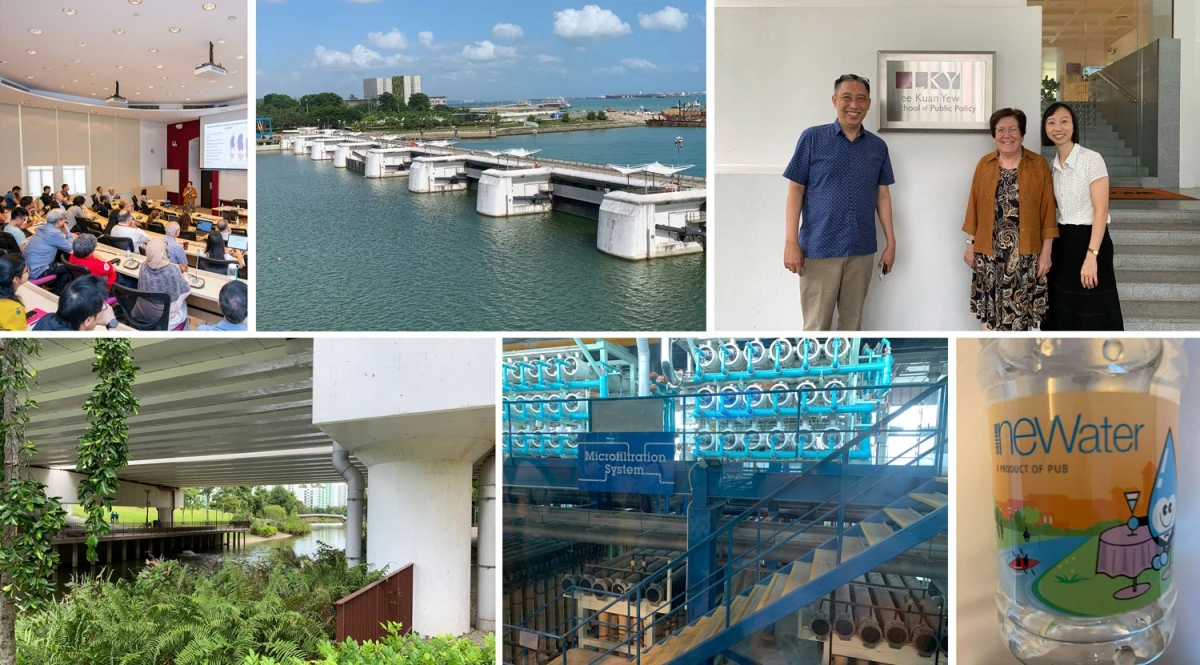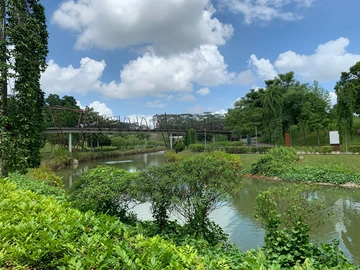
Photos (clockwise from top left): Seminar at the Institute of Water Policy, Lee Kuan Yew School of Public Policy, National University of Singapore; Marina Barrage; Dr. Sharon B. Megdal with Director Dr. Eduardo Araral and Deputy Director Dr. Corinne Ong, Institute of Water Policy; PUB NEWater bottled water; PUB NEWater Visitor Centre and Treatment Plant; Punggol Waterway, ABC Water Catchment Programme
I had the great privilege of visiting the Institute of Water Policy, Lee Kuan Yew School of Public Policy, at National University of Singapore the week of January 20, 2020. There I delivered two seminars, visited with faculty and other researchers, and had the opportunity to learn about Singapore’s water management. PUB, Singapore’s National Water Agency operating under the Ministry of the Environment and Water Resources, “manages Singapore’s water supply, water catchment and used water in an integrated way”. Like many, I had heard about their NEWater, but I was not aware of the extent of PUB’s integrated water management. I very much appreciate the hospitality of my hosts and their efforts to share their knowledge and information about Singapore’s water management. I certainly learned a lot during my visit!
My two seminars were the first of what I am calling my spring semester sabbatical lecture tour. The first seminar was entitled “Wicked Water Problems and Bridging through Water”. Since the concept of wicked water problems was discussed by Lisa Beutler at the WRRC’s 2016 annual conference, I have noted how many water challenges fit the characterization of wicked problems, which are problems that defy simple, single-path solutions. Key to identifying solution pathways is working across disciplines and with all stakeholders. The second seminar focused on Arizona and Colorado River Basin water management. The comparative size of our regions is a key differentiator, with Arizona alone over 400 times the size of Singapore. They use no groundwater, and we lack their abundance of rain and seawater supplies. Despite the many differences, I suggested some key take-aways: regardless of circumstances, there is a need to be ever-vigilant about water supply, quality, and utilization; sharing experiences and lessons learned is important; solution sets may differ, but involvement of stakeholders is critical; academia has a role to play in evaluating options and opportunities; connecting to the practice of water management is helpful to students, researchers, and educators; the issues are complex; and all want to avoid “crisis management”.
Through meetings and discussions, I had the opportunity to hear about the work of the Institute of Water Policy (IWP). Its research is applied, and much of it is connected to a five-year work plan funded by PUB. Singapore is unique in that it is an island city-state. All residents, who number over five million, are customers of PUB and all water catchments are managed by PUB. I visited PUB’s NEWater Centre, which is co-located with a NEWater production facility, the PUB Marina Barrage Visitor Centre, and a large public housing complex where water savings and a community garden are featured.
Singapore has developed a diverse portfolio of water resources to meet its growing water needs. NEWater is the third of PUB’s four national water taps. NEWater is described by PUB as the ultra-clean water produced from “used” water. In our terminology, it is highly treated or purified reclaimed water. Most of the NEWater is used by industry, but during dry periods some is added to the reservoirs where it blends with raw water, which is then treated for potable use. A small percentage is bottled, mostly for distribution at public events. I expected to be given a bottle at the NEWater Centre, but environmental concern about plastic water bottles has led to reduction in the distribution of NEWater bottles. I was given – and drank – a bottle of NEWater at one of my seminars.

The first of PUB’s four national water taps is water from local catchments. Singapore receives a lot of rain and catching it before it drains into the surrounding salt water is important, especially given its small, highly developed land area. Singapore has made an effort to improve and beautify its catchments. PUB uses the tag ABC, which stands for Active, Beautiful, Clean Waters Programme, to refer to the first national tap. The photo at right clearly shows that the catchments can be beautiful! It is interesting to note that, despite annual rainfall of over 90 inches, water scarcity is a concern. The second tap is imported water from the Malaysian state Johor; water importation agreements with Malaysia/Johor have a long history. The current agreement ends in 2061. As noted, the third national tap is NEWater; the fourth is desalinated water. As the PUB website notes: “In integrating the water system and maximising the efficiency of each of the four national taps, Singapore has overcome its lack of natural water resources to meet the needs of a growing nation.”
There is also a strong focus on water conservation and general sustainability. The Marina Barrage Visitor Centre, located adjacent to the Marina Barrage, emphasizes the message of sustainability. The Marina Barrage is one of Singapore’s key water infrastructure accomplishments. Completed as recently as 2008, the dam serves as a flood control structure that creates a key fresh water reservoir for Singapore while keeping the seawater out.
While in Singapore, I visited the Nanyang Technical University to spend some time with University of Arizona colleague Shane Snyder. It was interesting to hear about the multi-faceted efforts of the Nanyang Environment & Water Research Institute, for which Dr. Snyder serves as Executive Director.
A bonus for me was being in Singapore at the start of the Lunar New Year, a major holiday some liken to our Thanksgiving holiday because it is a time when families gather for meals and enjoy time away from work. Earlier that week I enjoyed a visit to Chinatown and seeing all the decorations in celebration of the Year of the Rat. On New Year’s Eve day, I went to the Singapore Botanic Gardens, including its famous orchid garden. Spending time at this UNESCO World Heritage site made for a beautiful and relaxing last day.
With the start of the Lunar New Year, I’d like to wish everyone a happy and prosperous year.
Weekly Wave, Vol. 8, Issue 5, February 7, 2020

